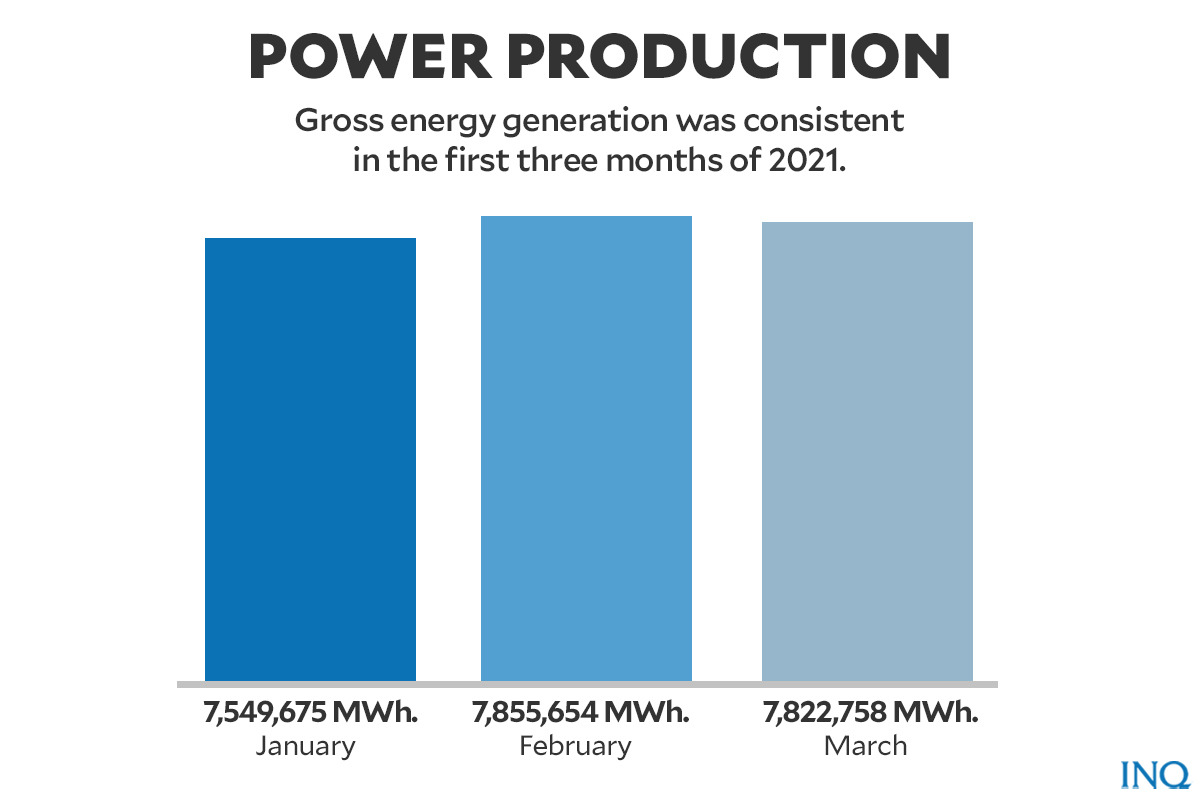Electricity: Supply, demand and more
MANILA, Philippines—As high temperatures persist despite the rainy weather last week, several areas in Luzon were hit by rotating power outages as electricity demand came too close to available supply.

INFOGRAPHIC BY ED LUSTAN
Among the areas hit by the brownouts were:
- Parts of Isabela
- Parts of Nueva Ecija—San Jose City and Pantabangan
- Parts of Camarines Sur
- Parts of Metro Manila
Some senators got a feel of the brownout, too, when the outage cut their internet connection at the height of the Senate’s plenary session which the legislators were attending online.
Luzon brownouts hit some senators, logging them out of Senate session
While the general explanation for the outages was that it was the result of a spike in demand, disruptions in supply of electricity actually have several definitions, according to the National Grid Corp. of the Philippines (NGCP), the private firm that maintains the country’s power transmission network.
According to NGCP, there are three types of power supply disruption:
Article continues after this advertisement- Power interruption—Not widespread. Electricity supply cut in select areas due mostly to scheduled service improvement or emergencies.
- Brownout—Covers a larger area. Carried out mainly by what is called as manual load dropping as a result of high demand and “to maintain the integrity of the power system.”
- Blackout—Widespread. Caused by total or partial system collapse in the power grid.

INFOGRAPHIC BY ED LUSTAN
The grid operator also regularly issues three types of alert signifying level of power supply:
Article continues after this advertisement- White—Supply is sufficient
- Yellow—Power reserve is low but not less than demand
- Red—Power reserve is no longer sufficient to meet demand.
NGCP declares a red alert when power reserve is less than 475 megawatts (MW). A yellow alert means reserve is less than 647 MW.
From May 31 to June 4, the Luzon grid was on red and yellow alerts as demand spiked and power supply was insufficient due to outages in several power plants.
Rotational brownouts continue as NGCP places Luzon Grid on Yellow, Red alert
Luzon power remains spotty, plants still offline
Tracing the source
The energy supply for the Luzon, Visayas, and Mindanao grids come from various sources.
Coal, oil-based, natural gas, and renewable energy are the main plant types used to supply energy for the Luzon grid. Data from the NGCP showed that a huge portion of the grid’s gross power generation output since last January came from coal power plants.
Coal power plants also remain the biggest source of energy for the Visayas grid followed by power produced by geothermal power plants
Mindanao’s two biggest power sources are coal power plants and hydroelectric power plants.

INFOGRAPHIC BY ED LUSTAN
The country’s total gross energy generation from January to March 2021 was 7,549,675 MWh, 7,855,654 MWh and 7,822,758 MWh.
In 2020, total gross power generation reached 101,755,720 MWh, lower by 4.04 percent than 106,041,488 MWh generated in 2019.
NGCP data also showed that power plants not under the National Power Corp. (Napocor) have generated the most electricity in years.
Power demand per sector
The Department of Energy, in its 2020 Power Statistics report, said that the residential sector consumed more electricity than industries and businesses.

INFOGRAPHIC BY ED LUSTAN
There was a total of 34,291,585 MWh in power consumed by the residential sector in 2020. It was followed by the industrial sector with a consumption of 25,566,327 MWh.
Commercial users consumed 20,727,103 MWh while other users consumed 2,658,768 MWh.
Costs and rates
In January, the lone power distributor in Metro Manila and its suburbs collected a P0.2744 per kilowatt hour (kWh) increase in rates, bringing the average monthly power rate to P8.7497 per kWh.
A typical household consuming 200 kWh per month was charged around P55 in electricity bill. Those who consumed 300 kWh, 400 kWh and 500 kWh paid an additional P82, P100 and P137.
Consumers, however, were treated to a two-month rate decrease last February and March. The overall rates went down by P0.0704 kWh and P0.3598 kWh which were equivalent to P8.6973 and P8.3195.
Meralco rates down in March billings
The rates went back up in April until May to P0.0872 and P0.1853. The overall rate amounted to P8.4067 and P8.59 per kWh.
Energy preservation
To prevent high electricity bills and help reduce demand in the power grids, NGCP has these tips for consumers:
- Avoid leaving appliances, like television, on “standby mode” since it consumes a lot of energy.
- Unplug appliances that are not in use.
- Clean air conditioner’s filter and condenser every six months.
- Always close doors and windows when using air conditioner—this will provide efficient cooling while keeping energy costs down.
- Regularly clean electric fan’s blades.
- Iron clothes at least once a week and schedule it during the “off-peak hours” – before 9 am or after 9 pm.
- Defrost refrigerator when over 1/4 inch of ice has covered the freezer’s surfaces.
- Always check if the refrigerator’s doors are closed shut.
- Wipe away dust from light bulbs using cloth or feather duster.
- Use Compact Fluorescent Lamps (CFL) or LED bulbs which are considered as more energy-efficient light sources.